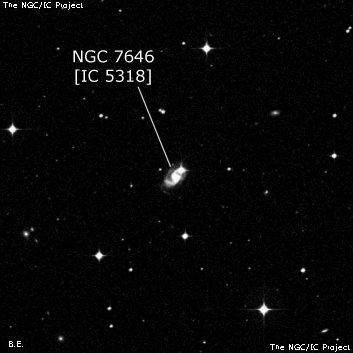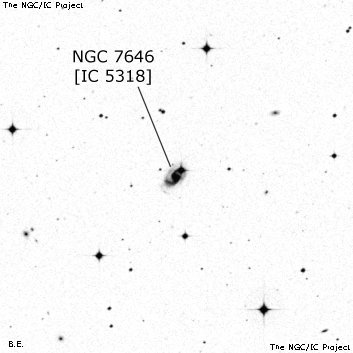NGC/IC Project Restoration Effort
(This is a very very beta version)
NGC7646


Basic Information
Location and Magnitude
Right Ascension: 23:24:6.9
Declination: -11:51:37
Constellation: AQR
Visual Magnitude: 13.3
Historic Information
Discoverer: Muller
Year of discovery: 1886
Discovery aperture: 26.3
Observational
Summary description: vF, vS, E 260° (neb?), * 9 n 3'.6
Sub-type: Sc
Corwin's Notes
=====
NGC 7646, which may be = IC 5318, is another of the Leander McCormick nebulae
found by Muller, with its discovery announced before a decent position was
available. Muller's description (magnitude = 14.5, diameter = 0.2 x 0.1,
extended 260 deg) would fit IC 5318 if he saw only the bar of the galaxy. He
also has a "*9, PA 10 deg, distance 3.6 arcmin." The star is actually 3.8
arcmin away at PA = 346 deg. Did Muller somehow get his PA into the wrong
quadrant? (There is no sketch to help us in this case).
The main thing that makes me question the identification is the star of
magnitude 9 or 10 superposed on the galaxy. Muller surely would have
mentioned the star had he noticed it -- since the nature of the nebulae was
still in debate in the late 1880's, nearby stars were often taken as possibly
physically associated with the nebulae.
IC 5318 was found by Herbert Howe, using Chamberlain Observatory's 16-inch
refractor. He measured the position of the galaxy, and noted the superposed
star but, because of Muller's poor position, did not make a connection with
the NGC number. Given the problems with Muller's position and description, we
should perhaps simply note the possibility of the identity, and let it go at
that.
-----
Looking at this again in May 2016, with more objective data at hand, I find
the V magnitude of the superposed star is listed at 11.66 in UCAC4. Similarly,
the star to the north has a V magnitude of 11.71, nearly three magnitudes
fainter than Muller's estimate of "9". Further, I also see another star of
similar brightness at approximately 4 arcminutes south-southwest of the
galaxy; its V magnitude is 10.85.
All this makes my supposition that Muller's object is IC 5318 far less likely,
so I've downgraded my colon on the identification to, not one, but two
question marks.
So, if NGC 7646 is probably not IC 5318, just what is it? Searches at all the
usual digit error positions turned up nothing, so the conclusion is -- as with
so many of these early Leander McCormick discoveries -- "Not Found."
-----
Coincidentally, Yann Pothier sent an email note suggesting that Muller's
object is the double star that I've noted in the table. This double has the
brighter star at the correct distance and position angle, and itself fits
Muller's description, particularly the magnitude and position angle of its
extention. This is a much better candidate for Muller's object than IC 5318,
so I've included it in the position table with a single colon.



